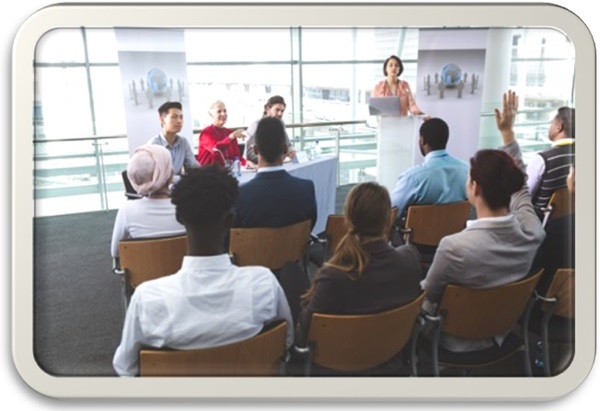Plan and execute a successful in-person conference
Planning and executing a successful in-person conference involves meticulous organization and attention to detail. With the cost of conferences being high, it is better to make sure THIS conference counts.
We can help to understand the essential steps to make an effective and excellent experience for all attendees.
Here are the key areas when organizing a conference:
Initial planning and venue selection – Understand the aim of the conference to be able to organise an effective and useful conference.
Venue Booking: Secure a conference venue that accommodates all your sessions, workshops, and additional events. Ensure that the venue offers appropriate breakaway rooms and that each space can be set up according to your specific requirements.
Due to the cost of booking venues, many companies have move to own premises conferences, or online conferencing. A venue however carries the responsibility of catering and setup, and thus popular for larger groups of people, and large companies


Conference Equipment and administrative services:
Verify the availability of essential services and equipment such internet access, projectors, audio-visual equipment.
Conference health and safety:
Ensure you have full health and safety specs, regarding how many people can enter the conference venue, how wires and electrical points work etc.
Registration and attendee management
Pre-Conference registration: Manage delegate registration efficiently with a pre-conference registration setup, ensuring a smooth process for payments and the compilation of attendee lists. Using an online membership management system for pre-payments, bookings and delegate contact information will make the process of organising a conference far more efficient, and possible save costs.


On-site conference registration:
Typically, conferences are pre-booked and paid for by delegates or their sponsors. Where there is on-site registration, create a clear registration area with clear, comprehensive signage to facilitate an easy check-in process for attendees. On-site conference registration should be avoided where security is a risk, and tightly and securely monitored.
With registration, create a clear plan of what is provided and expected from the delegate. If there is on-site accommodation, a pre-check of the rooms is a good idea to ensure all needs are catered for.
Conference program design and management
Designing the conference program when organising a conference, is directly related to the aim of the conference. Draft and print a detailed conference agenda that effectively allocates time for keynotes, sessions, and breaks.
Name tags and conference materials: Prepare name tags for all participants, including delegates, speakers, and exhibitors. Materials can be sent online, saving paper, printing, costs and allows the person to keep the material.
If possible, use sponsorships to create small gift bags, in exchange for advertising at the venue. Bags can be collected upon registration. Water points or water bottles should be placed on the tables before delegates arrive.
Exhibition and sponsorship
- Managing exhibitions: Create a clear area where exhibitors can set up their stands, as well as the policies or guidelines which should be followed. Often, the setup is done in the foyer or open welcome area, to ensure safety when the venue is locked up after the conference.
- Depending on the size of the conference, exhibitors are often responsible for their own setup and take down of their stands, as well as the security of the equipment brought with them. It is important to ensure that there is good communication regarding how the conference is going to work regarding their exhibition.
- Sponsorship management: Develop relationships with sponsors, handle promotional materials, and maintain a detailed sponsor list.


Conference logistics and additional arrangements
- Accommodation and transport: Arrange travel and accommodation for keynote speakers and committee members, and organize delegate transport between venues. Using keynote speakers from within the organisation can also be a more effective method, and more cost-effective.
- Crisis management: Implement a robust crisis management strategy to address any unexpected issues during the conference.
Enhancing the conference experience
Social events and networking opportunities:
Organize social events or evening functions, including seating arrangements and place cards if required, to enhance networking opportunities. Normally the more important guests such as speakers and executive will be seated close to the front.
Decor and extras:
When organising a conference, at a venue, the venue often does the general décor such as table-cloths, but water bottles will be charged per package. Branding and products specific to the company can be added by the company such as banners, flags, gazebos, wall banners etc. Offering custom gifts to speakers and sponsors to show appreciation is generally considered polite.

Post-conference follow-up
Feedback and evaluations:
Distribute post-conference evaluation forms to gather feedback from attendees, which is crucial for measuring success and planning future events. Feedback forms can be done online, with many of the free platforms available
Follow-up communications:
Send out thank you notes to speakers, sponsors, and attendees, reinforcing relationships and setting a positive tone for future interactions.
By paying close attention to these elements, you can successfully organise a conference that meets the expectations of all participants and sets a benchmark for future events. Remember, the key to a organising successful conference, lies in thorough preparation, effective communication, and a keen attention to detail.
